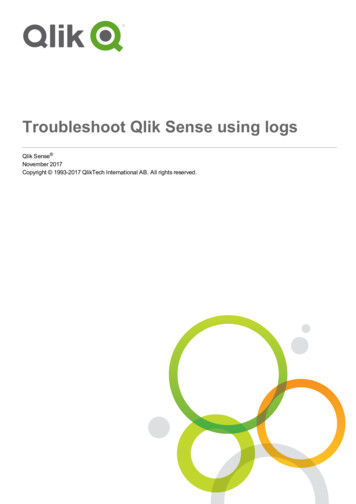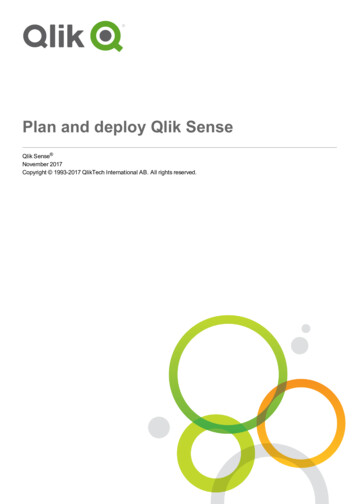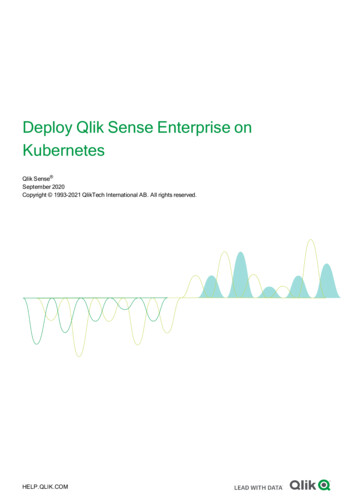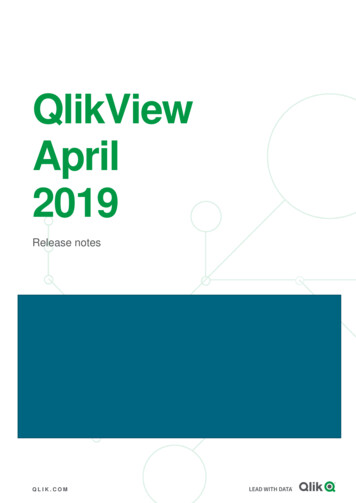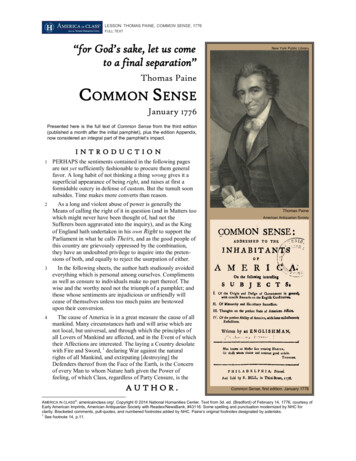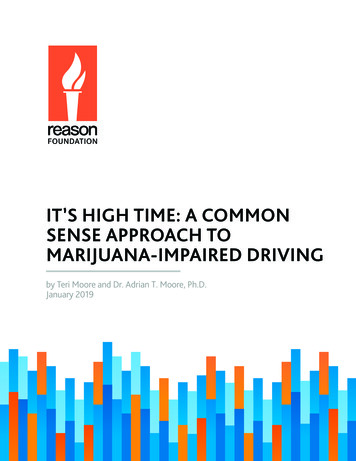
Transcription
IT’S HIGH TIME: A COMMONSENSE APPROACH TOMARIJUANA-IMPAIRED DRIVINGby Teri Moore and Dr. Adrian T. Moore, Ph.D.January 2019
Reason Foundation’s mission is to advance a free society by developing,applying and promoting libertarian principles, including individualliberty, free markets and the rule of law. We use journalism and publicpolicy research to influence the frameworks and actions of policymakers,journalists and opinion leaders.Reason Foundation’s nonpartisan public policy research promoteschoice, competition and a dynamic market economy as the foundationfor human dignity and progress. Reason produces rigorous, peerreviewed research and directly engages the policy process, seekingstrategies that emphasize cooperation, flexibility, local knowledgeand results. Through practical and innovative approaches to complexproblems, Reason seeks to change the way people think about issues,and promote policies that allow and encourage individuals andvoluntary institutions to flourish.Reason Foundation is a tax-exempt research and education organizationas defined under IRS code 501(c)(3). Reason Foundation is supported byvoluntary contributions from individuals, foundations and corporations.The views are those of the author, not necessarily those of ReasonFoundation or its trustees.The authors would like to thank Sgt. Thomas E. Page, LAPD (Ret.), for hisadvice and assistance.
IT’S HIGH TIME: A COMMON SENSE APPROACH TO MARIJUANA-IMPAIRED DRIVINGiEXECUTIVE SUMMARYRecent wide-spread legalization of medical marijuana and, in many U.S. states, ofrecreational use of marijuana also, demands that officials must forge a just, coherent andeffective law enforcement and legal response to marijuana-impaired driving. More andmore states are legalizing marijuana for medical and recreational use, which demandspolicies toward marijuana-impaired driving that protect public safety without penalizinglegal marijuana users who are sober at the time they drive.More and more states are legalizing marijuana for medical andrecreational use, which demands policies toward marijuana-impaireddriving that protect public safety without penalizing legal marijuanausers who are sober at the time they drive.Marijuana—or its more technical name, cannabis—and its effects are still quite literallyunder the microscope. Cannabis containing high levels of THC is typically usedrecreationally, but may also have therapeutic applications. Because it is the psychoactivecomponent in cannabis, THC is the cannabinoid that impairs driving, and is therefore thefocus of this study. This analysis examines the evidence on marijuana-impaired driving andTeri Moore and Dr. Adrian Moore
IT’S HIGH TIME: A COMMON SENSE APPROACH TO MARIJUANA-IMPAIRED DRIVINGiilays the groundwork for a regulatory approach that is scientifically grounded, safetyminded and fair.In the past 10 years, prevalence of alcohol use by drivers has fallen in the U.S., and use ofmarijuana has increased dramatically. Alcohol’s composition and effects on drivers havebeen thoroughly studied over the years and are well understood. It’s tempting to use asimilar approach to that used for alcohol—the only other legal intoxicant—and to buildpolicies around per se standards. But since cannabis body fluid levels don’t parallelimpairment, that’s not a fair gauge of impairment as it is with alcohol. Indeed, it’s possiblefor some cannabis users to register above per se levels when completely sober. It’s alsotempting to use the easy idea of zero tolerance, but that’s not fair to sober drivers who stillhave measurable cannabis in their systems.The only fair solution is for police to assess drivers for impairment as we now do for lowblood-alcohol-content impaired drivers and drug-impaired drivers, and to conducttoxicology screens to corroborate that cannabis is present, rather than measuring irrelevantlevels in body fluids. Fortunately, screenings are less expensive, quicker and easier to dothan measuring body fluid levels. It’s concerning that this means impairment will beassessed entirely by police officers, but that is the most just option currently available. Toaddress this concern, police should use dash- and bodycams to document impairingbehavior—such as driving behavior leading to the traffic stop and impairing behavior onfield sobriety tests—when possible.This approach suggests that police departments should prioritize their funding towardtraining DRE-qualified and/or ARIDE-qualified officers, as well as purchasing dash- andbodycams. States should also prioritize funding toward toxicology labs to prevent currentbacklogs, to ensure the speedy trials guaranteed by the U.S. Constitution.This evidence-of-impairment-based approach leads to these recommendations:1. Avoid per se standards and conduct THC detection screenings rather than assessingblood plasma levels, which don’t correlate to impairment.2. Mandate evidence of drug impairment as the main criterion for arrest. This targetsthe true danger to the public without penalizing sober users with detectable levelsof marijuana in their systems.Teri Moore and Dr. Adrian Moore It’s High Time: A Common Sense Approach to Marijuana-Impaired Driving
IT’S HIGH TIME: A COMMON SENSE APPROACH TO MARIJUANA-IMPAIRED DRIVINGiii3. Prioritize law enforcement training in ARIDE/DRE and dashcams and bodycams formore accurate and corroborative identification and assessment of drug-impaireddrivers, and to generate more useful data on marijuana-impaired drivers.4. Prioritize cutting down backlogs in toxicology laboratories so that justice for bothimpaired and unimpaired drivers is swift and fair. Rather than invasive testing ofirrelevant blood plasma levels, use quicker and less expensive cannabis detectionscreenings.5. At the federal level, deschedule marijuana to encourage research into marijuanaimpaired driving. This would remove obstacles to growing and procuring cannabisfor research purposes. While some regulations have loosened recently, it is notenough to encourage cannabis research. As well, the federal government shouldprioritize on-going NHTSA and university research on marijuana use and driving, andencourage development of reliable technology to aid in roadside impairmentdetermination.Teri Moore and Dr. Adrian Moore
IT’S HIGH TIME: A COMMON SENSE APPROACH TO MARIJUANA-IMPAIRED DRIVINGivTABLE OF CONTENTSPART 1:INTRODUCTION . 1PART 2:USING THE ALCOHOL-IMPAIRED DRIVING TEMPLATE FOR MARIJUANA . 42.1 METABOLISM OF ALCOHOL AND PER SE STANDARDS . 52.2 CANNABIS AND PER SE STANDARDS . 72.3 METABOLISM OF CANNABIS. 82.4 ZERO TOLERANCE CANNABIS-POSITIVE DRIVING POLICIES . 132.5 RAMIFICATIONS OF PER SE-BASED ARRESTS AND ZERO TOLERANCE POLICIESAND THE NEED FOR STANDARDS. 14PART 3:ASSESSMENT OF CANNABIS-IMPAIRED DRIVING . 163.1 CURRENT LAWS ON DRUG-IMPAIRED (INCLUDING ALCOHOL-IMPAIRED)DRIVING . 163.2 THE LOGICAL SOLUTION FOR CANNABIS-IMPAIRED DRIVING ASSESSMENT . 18PART 4:HOW LAW ENFORCEMENT DETERMINES AND ASSESSES DRIVING IMPAIRMENT . 194.1 FIELD SOBRIETY TESTS . 194.2 DRUG RECOGNITION EXPERT EVALUATIONS . 214.3 COMPENSATING FOR LAW ENFORCEMENT SUBJECTIVITY. 25PART 5:TYPES OF ROADSIDE CANNABIS TESTING AND EFFICACY . 295.1 IMPLIED CONSENT LAWS . 295.2 TYPES OF TESTING FOR MARIJUANA-IMPAIRED DRIVERS . 305.3 CANADA AT THE FOREFRONT. 34PART 6:CONCLUSION AND RECOMMENDATIONS . 35ABOUT THE AUTHORS . 37Teri Moore and Dr. Adrian Moore It’s High Time: A Common Sense Approach to Marijuana-Impaired Driving
IT’S HIGH TIME: A COMMON SENSE APPROACH TO MARIJUANA-IMPAIRED DRIVING1PART 1INTRODUCTIONIn the past 10 years, prevalence of alcohol use by drivers has fallen in the U.S., and use ofmarijuana has increased dramatically (see Table 1 below). While alcohol’s composition andeffects have been thoroughly studied over the years and are well understood, marijuana—or its more technical name, cannabis1—and its effects are still quite literally under themicroscope. In discussing its effects, it’s useful to know the basics about cannabis.TABLE 1: WEEKEND NIGHT-TIME PREVALENCE OF ALCOHOL AND MARIJUANA USE BYDRIVERS IN 2007 COMPARED TO ijuana8.6%12.6%SOURCE Berning, Amy, Richard Compton and Katherine Wochinger. “Results of the 2013-2014 National Roadside Surveyof Alcohol and Drug Use by Drivers.” DOT HS 812 rt-to-congress.pdf1This study uses both terms interchangeably.Teri Moore and Dr. Adrian Moore
IT’S HIGH TIME: A COMMON SENSE APPROACH TO MARIJUANA-IMPAIRED DRIVING2Of the nearly 500 natural compounds in cannabis, those unique to the plant are called“cannabinoids,” including CBD. Oils made from CBD are increasingly used in medicalapplications, and do not contain THC,2 the psychoactive substance in cannabis, and aretherefore not impairing. Cannabis containing high levels of THC is typically usedrecreationally, but may also have therapeutic applications. Because it is the psychoactivecomponent in cannabis, THC is the cannabinoid that impairs driving, and is therefore thefocus of this study.Recent wide-spread legalization of medical marijuana and, in manyU.S. states, of recreational use of marijuana also, demands thatofficials must forge a just, coherent and effective law enforcement andlegal response to marijuana-impaired driving.Recent wide-spread legalization of medical marijuana and, in many U.S. states, ofrecreational use of marijuana also, demands that officials must forge a just, coherent andeffective law enforcement and legal response to marijuana-impaired driving. While somestudies find minimal or no increased crash risk by drivers under the influence of cannabis,the majority do find an increased crash risk,3 with a significantly heightened crash riskwhen alcohol is used concomitantly with marijuana.4 With motor vehicle fatalities as thecurrent leading cause of death in young people ages 8-24, and in the top ten causes of2THC is short for delta-9 tetrahydrocannabinol.3Studies that do find a heightened crash risk for marijuana-impaired drivers assign it a far lowercrash risk than that of alcohol-impaired drivers. See Berghaus, G., N. Scheer and P. Schmidt.Effects of cannabis on psychomotor skills and driving performance—a meta-analysis of experimentalstudies. In Kloeden, C. N., and A. J. McLean (Eds.), Proceedings of the 13th InternationalConference on Alcohol, Drugs and Traffic Safety. Adelaide: NHMRC Road Accident ResearchUnit, 1995. Also, Compton, Richard. Marijuana-Impaired Driving: A Report to Congress. NationalHighway Traffic Safety Administration. July 2017. And Romano, E., P. Torres-Saavedra, R. Voasand J. H. Lacey. “Drugs and Alcohol: Their Relative Crash Risk.” Journal of Studies on Alcohol andDrugs. 2014. 1-9.4Romano, et al. “Drugs and Alcohol.” 1-9.Teri Moore and Dr. Adrian Moore It’s High Time: A Common Sense Approach to Marijuana-Impaired Driving
IT’S HIGH TIME: A COMMON SENSE APPROACH TO MARIJUANA-IMPAIRED DRIVING3death for all ages under 65,5 and with a large portion of those fatalities due to drivingunder the influence of alcohol and/or drugs,6 it’s vital to protect the driving public fromimpaired drivers. Yet it’s also just as important to guard against an overly cautiousapproach that punishes unimpaired legal marijuana users who are sober, attentive and alertdrivers. This study examines the evidence on marijuana-impaired driving and lays thegroundwork for a regulatory approach that is scientifically grounded, safety-minded andfair.5U.S. Department of Transportation. National Highway Traffic Safety Administration. TrafficSafety Facts: Research Note, Summary of Statistical Findings. “Motor Vehicle Crashes as aLeading Cause of Death in the United States, 2015.” Table “The 10 Leading Causes of Death inthe United States in 2015, by Age Group.” DOT HS 812 499. Publication/8124996National Highway Traffic Safety Administration. Traffic Safety Facts 2016 data: alcohol-impaireddriving. U.S. Department of Transportation, Washington, DC.2017. blication/812450 Accessed 2 October2018.Teri Moore and Dr. Adrian Moore
IT’S HIGH TIME: A COMMON SENSE APPROACH TO MARIJUANA-IMPAIRED DRIVING4PART 2USING THE ALCOHOLIMPAIRED DRIVINGTEMPLATE FORMARIJUANAIdeally, drugged driving impairment should be measurable against a biological standard ofsome sort, as seen with blood alcohol concentration (BAC) measurement in alcoholimpaired drivers. Such a standard allows legal drug users—whether on prescriptionmedication, cannabis medication, or recreational use of alcohol or cannabis—to gauge theiruse responsibly. For example, alcohol users can estimate the strength of their drinksagainst their own physical size and what they’ve eaten to get a rough idea of their BAC.Because all U.S. states7 peg per se alcohol impairment at .08% BAC level, drivers can get asense of the amount of drinking that is likely to impair their driving. There are manyvariables, and many people are impaired well before reaching .08% BAC, but both driversand law enforcement have a distinct level under which impairment is assumed, which is ascientifically based standard. Logically, states have turned to this high-utility template for7Utah’s bill to drop the per se limit to .05% BAC is set to go into effect December 30, 2018.Romboy, Dennis. “Utah House committee rejects bill to delay .08% DUI law.” Deseret News.February 28, 2018. tmlTeri Moore and Dr. Adrian Moore It’s High Time: A Common Sense Approach to Marijuana-Impaired Driving
IT’S HIGH TIME: A COMMON SENSE APPROACH TO MARIJUANA-IMPAIRED DRIVING5cannabis-impaired driving. But alcohol and cannabis differ dramatically, especially in howthey metabolize in the body, which is critical to impairment detection and assessment.2.1METABOLISM OF ALCOHOL AND PER SE STANDARDSUnlike many drugs, alcohol is “hydrophilic,” meaning it is water-soluble, dispersingthroughout the body’s water storage and processing systems. Taking into account aperson’s size, blood volume, stomach contents and metabolic rate, among other variables, agiven dose of alcohol can be calculated to accurately estimate the level of blood alcoholconcentration in a subject. Since alcohol begins metabolizing immediately, quicklyoverwhelming the liver’s ability to process it, and then continues to metabolize at aconstant, predictable rate, BAC can be determined not only at the time a sample was given,but can also be extrapolated back in time with some accuracy, which is helpful in assessingimpairment levels in post-crash circumstances.Currently, scientific evidence finds that significant impairment occurs inthe majority of drivers at .05 BAC and in nearly all drivers at .08 BAC.Because alcohol impairment tracks directly with BAC, impairment levels can be estimatedat various BAC levels. Currently, scientific evidence finds that significant impairment occursin the majority of drivers at .05 BAC and in nearly all drivers at .08 BAC.8 In the U.S., thisassociation has led to all 50 states establishing a .08 BAC as a per se quantitative cut offpoint for assumption of impairment.9 While police can arrest a driver for lower BAC levelsby providing evidence of impairment, drivers who meet the .08% BAC level can be charged8Moskowitz, H. and D. Fiorentino. “A Review of the Literature on the Effects of Low Doses ofAlcohol on Driving-Related Skills.” Washington, DC: US Department of Transportation, NationalHighway Traffic Safety Administration; 2000. (DOT HS 809 028). Also, Moskowitz, H. and C. D.Robinson. “Effects of low doses of alcohol on driving-related skills: A review of the evidence.”(Report No. DOT HS 807 280) Washington, DC: National Highway Traffic Safety Administration,SRA Technologies, Inc. 1988.9Utah’s bill to drop the per se limit to .05% BAC is set to go into effect December 30, 2018.Romboy. “Utah House committee rejects bill to delay .08% DUI law.”Teri Moore and Dr. Adrian Moore
IT’S HIGH TIME: A COMMON SENSE APPROACH TO MARIJUANA-IMPAIRED DRIVING6without evidence of impairment. It is alcohol’s water-soluble characteristic that allows forthis correlation with impairment, a characteristic that renders it an outlier among manypsychoactive drugs in current widespread recreational use.2.1.1 BENEFITS OF PER SE LEVELSEstablishing per se levels, as all states have done for alcohol, has many benefits: Per se levels are specific, applicable to all regardless of size, gender, etc. and simpleto understand. Drivers know the law and can estimate how much they can drink and how long agiven dose of alcohol will likely take to process through their system. Prosecutors need only meet the easily and accurately testable .08% BAC to bringcharges, without the lengthy, labor-intensive process of having to establishimpairment. Meeting or exceeding .08% BAC cleanly and clearly stipulatesimpairment in a court of law. Because the per se level for alcohol is scientifically sound based on thoroughstudies since the 1950s, standardized throughout the nation, and quick and easy todetermine biologically in drivers, court cases tend to resolve quickly, either throughpleas or trials, saving the courts and defendants time and money. Using the fairly simple and affordable technology used in alcohol breathalyzers,police officers can test drivers at roadside during the traffic stop, allowing for timely,non-invasive results that do not require lengthy observed behavioral sobriety testingto assess and arrest for impairment (although such field sobriety testing is routinelydone anyway). Because this allows for quicker arrests, more police officers areavailable for other calls, and less time is spent on the side of the road, which isinherently dangerous, especially for impaired persons. Per se levels give a sense of fairness to the general public and the justice system.Because alcohol impairment tracks so closely to blood alcohol concentration, trulyimpaired drivers are being removed from the roadways—a policy that garners highpublic approval.It’s no wonder that many states legalizing recreational marijuana use—and some states thathave legalized only medical use—have followed the template employed to determinealcohol-impaired driving by criminalizing per se levels of THC concentrations in blood.Teri Moore and Dr. Adrian Moore It’s High Time: A Common Sense Approach to Marijuana-Impaired Driving
IT’S HIGH TIME: A COMMON SENSE APPROACH TO MARIJUANA-IMPAIRED DRIVING2.27CANNABIS AND PER SE STANDARDSU.S. states run the gamut regarding cannabis-impaired driving approaches. As of thisstudy’s publication, 30 states,10 many of which have legalized medical marijuana use, havezero tolerance policies for THC in drivers. A few that have legalized only medical cannabishave per se standards for impaired driving.11 While some states with legal recreationalcannabis have set per se limits that assume impairment, most have no specific set limits,preferring to establish impairment through other means.TABLE 1: HOW STATES WITH CANNABIS PER SE LIMITS AND/OR LEGALIZED CANNABISAPPROACH THC-IMPAIRED DRIVINGStateAlaskaCaliforniaColoradoMedical MJ Legal?YesYesYesRecreational MJ Legal?YesYesYesWashington, YesNoYesNoYesNoYesImpaired DrivingNo Specific LawNo Specific LawReasonable InferenceFor THC 5 Ng*No Specific LawNo Specific LawNo Specific LawTHC Per Se 5 NgTHC Per Se 2 NgTHC Per Se 2 NgNo Specific LawTHC Per Se 1 NgTHC Per Se 5 Ng*NOTE: “Reasonable Inference for THC 5 NG means that it can be inferred (by a jury or other legal parties) that a driverwith at least 5ng/ml of THC in their blood is likely to be impaired. Such a designation is one step removed from thepresumptive assumption of impairment inherent in per se levels.Source: Governors Highway Safety Association. ired%20driving10See the Governors Highway Safety Association state-by-state list of cannabis-impaired drivinglaws here: ired%20driving11In the table, “ng/ml” means “nanograms of THC per milliliter of blood plasma.”Teri Moore and Dr. Adrian Moore
IT’S HIGH TIME: A COMMON SENSE APPROACH TO MARIJUANA-IMPAIRED DRIVING8It’s important to remove impaired drivers from the road without unfairly implicating theunimpaired. With per se limits, that involves establishing a direct and parallel relationshipbetween blood levels of THC and levels of impairment. Using the data from DUI arrests,researchers have studied this very relationship. Overall, they find that per se laws facemany challenges when cannabis’s metabolic factors are taken into account.METABOLISM OF CANNABISUnlike alcohol, which is “hydrophilic,” cannabis is “lipophilic,” meaning that it is stored inthe fatty tissues of the body. This characteristic means that cannabis compounds, includingthe psychoactive THC, store and are detectable long term, up to a month or longer ofabstinence, as THC leaches into the bloodstream from fatty tissues. Blood plasma levelsand impairment vary greatly in subjects given the same dose. But blood plasma levels dofollow a general trajectory after use.FIGURE 1: TIME COURSE OF STANDARDIZED THC CONCENTRATION IN PLASMA,PERFORMANCE DEFICIT AND SUBJECTIVE HIGH AFTER SMOKING MARIJUANA120100Subjective HighPercent of Peak2.39060Performance Deficit (% baseline)4020THC Concentration (ng/ml)00153045607590105120135150Time After Smoking (minutes)Source: National Highway Traffic Safety Administration. Marijuana-Impaired Driving: A Report to Congress. July 2017. Chartadapted from Berghaus et al. 1998, Sticht and Kaeferstein 1998 and Robbe 1994.Teri Moore and Dr. Adrian Moore It’s High Time: A Common Sense Approach to Marijuana-Impaired Driving
IT’S HIGH TIME: A COMMON SENSE APPROACH TO MARIJUANA-IMPAIRED DRIVING9 THC level in blood plasma rises sharply after smoking, then peaks andrapidly declines.As Figure 1 shows, THC level in blood plasma rises sharply after smoking, then peaks andrapidly declines. Meanwhile, during that blood plasma level decline, performance deficit(a.k.a. impairment) is still rising, then peaks and remains relatively strong, even after THClevels have declined below many state per se levels. Peak impairment, occurring at 90minutes after smoking, coincides with an 80% drop in THC level. Indeed, studies havefound that the majority of DUI arrestees with only cannabis in their systems had bloodplasma THC levels below the 5mg/mL per se standard.12 This is likely because, in the realworld of police work, the time between the traffic stop and drawing the biologicalspecimen averages 165 minutes, rendering such a high per se standard virtually irrelevant.As the National Highway Traffic Safety Administration (NHTSA) finds, “While very highlevels of THC do indicate recent consumption (by smoking marijuana) it is very unlikely apolice officer would encounter a suspect and obtain a sample of blood or oral fluid within ashort enough time for high THC levels to be detected .”13 This means that states that relyon per se levels are likely to release drivers with below-per-se levels who are still quiteimpaired. As the chart shows, per se levels do not track parallel to impairment. Therefore,low blood plasma levels of THC are not a reliable indicator of recent cannabis use.The initial peak blood plasma level in the chart shows that very high blood plasma levels ofTHC do indicate recent use, pointing to setting a high per se level. But such a high per selevel suggests that under that amount a driver is not likely to be impaired, which is notsupported by the chart. Such a policy is likely to also result in the release of many veryimpaired drivers on the roadway. Beyond the failure of blood plasma levels to correlate toimpairment, THC metabolism is subject to several other variables, making for a highlyindividualized response.12Logan, Barry, Sherri Kacinko, Douglas Beirness. “An Evaluation of Data from Drivers Arrested forDriving Under the Influence in Relation to Per se Limits for Cannabis.” AAA Foundation forTraffic Safety. May 2016.13Compton, Richard. Marijuana-Impaired Driving: A Report to Congress. National Highway TrafficSafety Administration. July 2017.Teri Moore and Dr. Adrian Moore
IT’S HIGH TIME: A COMMON SENSE APPROACH TO MARIJUANA-IMPAIRED DRIVING102.3.1 VARIABLE: METHOD OF INGESTIONWhile Figure 1 shows the trajectory of impairment for smoking cannabis, it does notaccount for the other methods of ingestion that have different trajectories. For example,eating cannabis via cannabis-laced edibles takes longer to impart impairment due to thetime it takes to absorb through the digestive system. Because THC takes a longer time to befelt by the user, often higher quantities are ingested, making for inadvertent higherimpairment. Moreover, even at these higher doses, edible cannabis is metabolized primarilyby the liver, which sends less THC to the bloodstream, resulting in lower blood plasmalevels compared to smoked cannabis, yet with a similar or higher peak quantity of THC inthe body.14 Figure 2 contrasts the rise, peak and decline of THC for smoked and eatencannabis. As these quantities are metabolizing in the body, impairment is rising, peakingand remaining quite high long after the amount of THC measurable in the body, both forsmoked and eaten cannabis, has fallen. The researchers note that edible THC registeredmuch lower plasma concentrations and much slower onset and longer effects than smokedcannabis did in the dosed subjects.15Other ingestion methods skew the correlation with impairment as well. The Ohlsson studyshowed a similar THC effect and blood plasma concentration trajectory between smokedand injected cannabis, and a quite different one for edibles, which register a much lowerTHC blood plasma level for the same dose.16 Still other research finds that rectal use ofcannabis (in this case via suppositories) imparts virtually immediate absorption—faster thanall other methods of ingestion.17 Research finds that “The bioavailability of the rectal routewas approximately twice that of the oral route due to higher absorption and lower firstpass metabolism.”1814Hollister L. E., H. K. Gillespie, A. Ohlsson, J. E. Lindgren, A. Wahlen and S. Agurell. “Do plasmaconcentrations of delta 9-tetrahydrocannabinol reflect the degree of intoxication?” Aug-Sep1981. 21(S1).171S-177S. on, A., J. E. Lindgren, A. Wahlen, S. Agurell, L. E. Hollister and H. K. Gillespie. “Plasma delta9 tetrahydrocannabinol concentrations and clinical effects after oral and intravenousadministration and smoking.” Clinical and Pharmaceutical Therapeutics. Sep. 1980 28(3):409-416.16Ibid. Also see Huestis, Marilyn A. “Human Cannabinoid Pharmacokinetics.” Chemical Biodiversity.Aug. 2007. 4(8). 1770-1804. 18/17This is true of the majority of drugs, including alcohol, due to immediate access to the arterialbloodstream.18Huestis. “Human Cannabinoid Pharmacokinetics.”Teri Moore and Dr. Adrian Moore It’s High Time: A Common Sense Approach to Marijuana-Impaired Driving
IT’S HIGH TIME: A COMMON SENSE APPROACH TO MARIJUANA-IMPAIRED DRIVING11FIGURE 2: INTOXICATING EFFECT DURATIONS OF SMOKED VS. EATEN CANNABISPotency of effect: 100 smoked peak10050%50%101011Smoked cannabis:fast peak, rapid drop060120Eaten100Smoked180Eaten cannabis:slow build, long effect240Duration of effect Expressed in Minutes060120180240300360Duration of effect Expressed in MinutesSource: Ohlsson, A. et al. “Plasma delta-9 tetrahydrocannabinol concentrations and clinical effects after oral andintravenous administration and smoking.” Clinical and Pharmaceutical Therapeutics. Sep. 1980 28(3):409-416.2.3.2 VARIABLE: FREQUENCY OF USEAnother variable is whether the user is new to THC or a frequent user—a variable thatsignificantly skews impairment levels among users at the same dosage, as well as theirblood plasma levels. This is due to the cannabis’s long half-life (67 days) in humans.19Research on frequent and long-term recreational cannabis users finds that, since cannabisstores in the fatty tissues of the body and can be released long after sobriety, chronic usersmaintain a certain amount of measurable THC in their plasma at all times, even whilesober, sometimes exceeding the
current leading cause of death in young people ages 8-24, and in the top ten causes of 2 THC is short for delta-9 tetrahydrocannabinol. 3 Studies that do find a heightened crash risk for marijuana-impaired drivers assign it a far lower crash risk than that of alcohol-impaired drivers. See Berghaus, G., N. Scheer and P. Schmidt.


